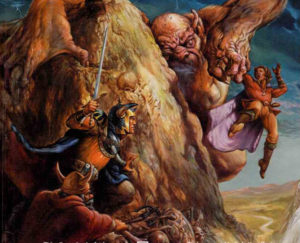Mountains: More than a Speed-bump, less than Survivalist Porn?
 Recently, my AD&D 1E campaign involved some travel and exploration within a mountain range, including scaling one particular peak in search of a dragon’s lair. My preparation suggested two possible approaches to mountaineering by-the-book: the dry application of a movement speed penalty (DMG) or a hyper-realistic treatment that assumes both a detailed area map and skill system that I don’t use (Wilderness Survival Guide). Faced with those extremes, I decided to put together my own system that offered a bit more than a speed bump but still adhered to the “keep it simple” ethos of early editions and the OSR. I make no claims to realism or balance, but it worked pretty well for a couple of sessions and can probably be modified to cover other “hazardous terrain” situations.
Recently, my AD&D 1E campaign involved some travel and exploration within a mountain range, including scaling one particular peak in search of a dragon’s lair. My preparation suggested two possible approaches to mountaineering by-the-book: the dry application of a movement speed penalty (DMG) or a hyper-realistic treatment that assumes both a detailed area map and skill system that I don’t use (Wilderness Survival Guide). Faced with those extremes, I decided to put together my own system that offered a bit more than a speed bump but still adhered to the “keep it simple” ethos of early editions and the OSR. I make no claims to realism or balance, but it worked pretty well for a couple of sessions and can probably be modified to cover other “hazardous terrain” situations.
Mountain Terrain Assumptions: Movement and Time
- Movement across mountainous terrain: 1/4 Speed
- Climbing Mountains (Average): 4 hours to tree line; 6 hours from tree line to peak
Mountain Exploration Process
Below the Tree Line
- In addition to normal encounter checks, roll a d6 for each hour of the climb
- On a result of 6, the party encounters a special event; roll 2d6 on the event table below
- Roll another d6 to determine which turn within the hour the event occurs
Above the Tree Line
- In addition to normal encounter checks, roll d6 for each hour of the climb
- On a result of 5 or 6, the party encounters a special event; roll 2d6 on the event table below
- Roll another d6 to determine which turn within the hour the event occurs
- Roll another d6 to determine if the special event coincides with an encounter
Special Event Table
| 2 | Rock slide! All party members save vs. paralyzation or tumble 10′ (d6 damage); save again or continue tumbling d4x10′ (4d6 damage); repeat until dead or successful save. |
| 3 | Path split by chasm with no obvious means of crossing; width of chasm is 4d6x10′ (add another d6 for every result of 6); depth of chasm is 8d6x10′ (add another d6 for every result of 6) |
| 4 | Path split by chasm with weathered bridge (20% chance it is a rusted automaton collapsed to form bridge); roll d6 for each character crossing — on the second result of 6, save vs. paralyzation or fall unless secured (see above for width/depth of chasm) |
| 5 | Path obliterated by rock slide creating treacherous terrain; d6 for each character crossing and save vs. paralyzation for all fails or tumble 10′ (d6 damage); save again or continue tumbling d4x10′ (4d6 damage), etc. |
| 6 | Sheer wall impedes progress; thief or grappling hook needed to scale with rope required for others to follow (height of face: 4d6x10′, rolling again for each 6 result); if no means of ascent, an hour detour to find alternative route. |
| 7 | Sheer wall with overhang impedes progress; thief or grappling hook to scale (thief skill at -15%) and rope needed for others to follow (see above for height of face); if no means of ascent, an hour detour to find alternative route. |
| 8 | Cave with 60% chance of lair (roll on random encounter table immediately); 20% chance that cave is a shortcut to higher/lower area, cutting off one hour of travel. |
| 9 | Drop-off next to path leaving only a narrow ledge; roll d6 for each character passing and on third result of 6, save vs. paralyzation or lose footing; fall is 8d6x10′, rolling again for each result of 6. |
| 10 | Path split by swift-moving stream cascading down mountain; treacherous footing means d6 roll for each character crossing with every 2nd result of 6 requiring a save vs. paralyzation or fall (d4x10′ distance). |
| 11 | Exposed section of path where wind whips around mountain; cannot effectively communicate for d6 turns, otherwise safe. |
| 12 | Large rock dislodged from above path; randomly determine targets in character group and roll to hit as 7HD monster (can target any number of targets within 10′ of each other); 2d6 damage on hit and save vs. paralyzation to avoid fall (d4x10′ feet) |
Notes on Table:
- Improvise strength check if characters tied together with rope and some succeed and others fail required saves
- Cross off events as used; replace table items as needed with new events between game sessions
- Above tree line, roll for random encounter with special event (i.e., ambushes utilizing special event feature)
Some Considerations
All of this is meant to be random and loose — and that also means there will be a lot of minutiae to adjudicate in the moment. Still, I found this more satisfying than just making the trip take longer or needing to map out the entire mountain and place interesting features ahead of time.
